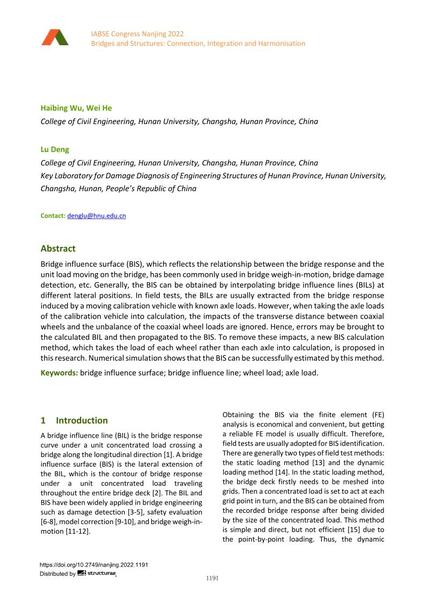A New Method for Calculating Bridge Influence Surface

|
|
|||||||||||
Détails bibliographiques
| Auteur(s): |
Haibing Wu
(College of Civil Engineering, Hunan University, Changsha, Hunan Province, China)
Wei He (College of Civil Engineering, Hunan University, Changsha, Hunan Province, China) Lu Deng (College of Civil Engineering, Hunan University, Changsha, Hunan Province, China; Key Laboratory for Damage Diagnosis of Engineering Structures of Hunan Province, Hunan University, Changsha, Hunan, People’s Republic of China) |
||||
|---|---|---|---|---|---|
| Médium: | papier de conférence | ||||
| Langue(s): | anglais | ||||
| Conférence: | IABSE Congress: Bridges and Structures: Connection, Integration and Harmonisation, Nanjing, People's Republic of China, 21-23 September 2022 | ||||
| Publié dans: | IABSE Congress Nanjing 2022 | ||||
|
|||||
| Page(s): | 1191-1199 | ||||
| Nombre total de pages (du PDF): | 9 | ||||
| DOI: | 10.2749/nanjing.2022.1191 | ||||
| Abstrait: |
Bridge influence surface (BIS), which reflects the relationship between the bridge response and the unit load moving on the bridge, has been commonly used in bridge weigh-in-motion, bridge damage detection, etc. Generally, the BIS can be obtained by interpolating bridge influence lines (BILs) at different lateral positions. In field tests, the BILs are usually extracted from the bridge response induced by a moving calibration vehicle with known axle loads. However, when taking the axle loads of the calibration vehicle into calculation, the impacts of the transverse distance between coaxial wheels and the unbalance of the coaxial wheel loads are ignored. Hence, errors may be brought to the calculated BIL and then propagated to the BIS. To remove these impacts, a new BIS calculation method, which takes the load of each wheel rather than each axle into calculation, is proposed in this research. Numerical simulation shows that the BIS can be successfully estimated by this method. |
||||
| Copyright: | © 2022 International Association for Bridge and Structural Engineering (IABSE) | ||||
| License: | Cette oeuvre ne peut être utilisée sans la permission de l'auteur ou détenteur des droits. |
||||
